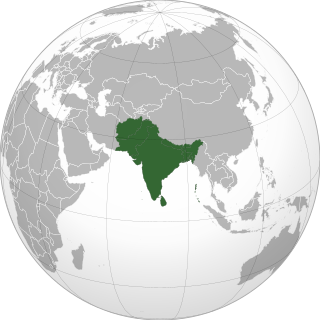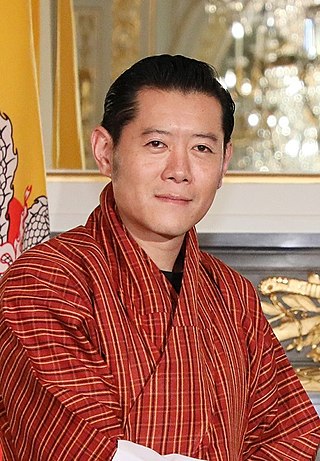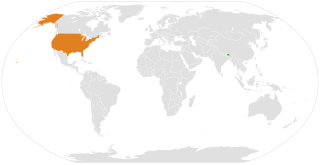Related Research Articles

Bhutan's early history is steeped in mythology and remains obscure. Some of the structures provide evidence that the region has been settled as early as 2000 BC. According to a legend it was ruled by a Cooch-Behar king, Sangaldip, around the 7th century BC, but not much is known prior to the introduction of Tibetan Buddhism in the 9th century, when turmoil in Tibet forced many monks to flee to Bhutan. In the 12th century, the Drukpa Kagyupa school was established and remains the dominant form of Buddhism in Bhutan today. The country's political history is intimately tied to its religious history and relations among the various monastic schools and monasteries.

Thimphu is the capital and largest city of Bhutan. It is situated in the western central part of Bhutan, and the surrounding valley is one of Bhutan's dzongkhags, the Thimphu District. The ancient capital city of Punakha was replaced by Thimphu as capital in 1955, and in 1961 Thimphu was declared as the capital of the Kingdom of Bhutan by the 3rd Druk Gyalpo Jigme Dorji Wangchuck.

Jigme Singye Wangchuck is a member of the House of Wangchuck who was the king of Bhutan from 1972 until his abdication in 2006.

Jigme Dorji Wangchuck was the 3rd Druk Gyalpo of Bhutan.

Gross National Happiness (GNH), sometimes called Gross Domestic Happiness (GDH), is a philosophy that guides the government of Bhutan. It includes an index which is used to measure the collective happiness and well-being of a population. Gross National Happiness Index is instituted as the goal of the government of Bhutan in the Constitution of Bhutan, enacted on 18 July 2008.
Articles related to Bhutan include:

Dechencholing Palace is located in Thimphu, the capital of Bhutan, 4 kilometres (2.5 mi) to the north of the Tashichho Dzong and 7 kilometres (4.3 mi) north of the city centre. It was built in 1953 by the third king of Bhutan Druk Gyalpo Jigme Dorji Wangchuck.
DashoLhendup Dorji was a member of the Dorji family of Bhutan. He was also the brother of the Queen of Bhutan, Ashi Kesang choden and uncle to the fourth king of Bhutan, King Jigme Singye Wangchuck. He served as acting Lyonchen following the assassination of his brother, Lyonchen Jigme Palden Dorji, on April 5, 1964.

Jigme Khesar Namgyel Wangchuck is the Druk Gyalpo, the monarch of the Kingdom of Bhutan. After his father Jigme Singye Wangchuck abdicated the throne, he became the monarch on 9 December 2006. A public coronation ceremony was held on 6 November 2008, a year that marked 100 years of monarchy in Bhutan.

The Communist Party of Bhutan (Marxist–Leninist–Maoist) (abbr. CPB (MLM)) is an underground communist party in Bhutan.
Princess AshiKesang Choden Wangchuck, is a member of the royal family of Bhutan. She is a daughter of the fourth King of Bhutan Jigme Singye Wangchuck and Queen Mother Ashi Tshering Pem Wangchuck, one of the former king's four wives, all of whom are sisters and held the title 'queen consort'. She is a half-sister of the current Druk Gyalpo Jigme Khesar Namgyel Wangchuck, who became king following the abdication of his father Jigme Singye Wangchuck on 9 December 2006.
The development of Bhutanese democracy has been marked by the active encouragement and participation of reigning Bhutanese monarchs since the 1950s, beginning with legal reforms such as the abolition of slavery, and culminating in the enactment of Bhutan's Constitution. The first democratic elections in Bhutan began in 2007, and all levels of government had been democratically elected by 2011. These elections included Bhutan's first ever partisan National Assembly election. Democratization in Bhutan has been marred somewhat by the intervening large-scale expulsion and flight of Bhutanese refugees during the 1990s; the subject remains somewhat taboo in Bhutanese politics.

Bhutan–Nepal relations refer to the bilateral relations between the Bhutan and Nepal. Relations were formally established in 1983. The two Himalayan countries are both landlocked, separated only by the Indian State of Sikkim. Both countries are bordered by India and the People's Republic of China. However, the current state of relations remains strained owing to the Bhutanese refugee crisis.
Prince DashoUgyen Jigme Wangchuck is a member of the royal family of Bhutan and is the youngest of the sons of the fourth King of Bhutan Jigme Singye Wangchuck and his wife, Queen Mother Ashi Tshering Pem Wangchuck.
Public holidays in Bhutan consist of both national holidays and local festivals or tshechus. While national holidays are observed throughout Bhutan, tsechus are only observed in their areas. Bhutan uses its own calendar, a variant of the lunisolar Tibetan calendar. Because it is a lunisolar calendar, dates of some national holidays and most tshechus change from year to year. For example, the new year, Losar, generally falls between February and March.

Desi Jigme Namgyal of Bhutan is a forefather of the Wangchuck Dynasty. He served as 48th Druk Desi of Bhutan (1870–1873), and held the hereditary post of 10th Penlop of Trongsa. He was called the Black Ruler.
Princess AshiChimi Yangzom Wangchuck is a princess of Bhutan. She is the daughter of the fourth King of Bhutan Jigme Singye Wangchuck and Queen Mother Ashi Tshering Pem Wangchuck. She is a half-sister of the fifth King, Jigme Khesar Namgyel Wangchuck. She is eighth in the line of succession to the Bhutanese throne.
Lam Dorji was the Chief Operations Officer (COO) of the Royal Bhutan Army (RBA) from 1964 to 2005. He was succeeded by Batoo Tshering on 1 November 2005.
Ashi Phuntsho Choden (1911–2003) was the Queen consort of Bhutan.

Bhutan and the United States have no formal diplomatic relations, but relations between the two nations are viewed as "friendly and close", due to shared values between the two countries. The increasingly close relationship between India and the U.S. has also helped to improve U.S.–Bhutanese relations.
References
- ↑ United Revolutionary Front of Bhutan. (2008, Feb 4) ”Declaration by United Revolutionary Front [Press Release].” Retrieved from http://www.scoop.co.nz/stories/WO0802/S00022.htm
- ↑ (2009, May 7) "The Bhutan Insurgencies" The Diplomat. Retrieved from https://thediplomat.com/2009/05/the-bhutan-inssurgencies/
- ↑ Castillo, Adam C. (2019) "Bhutan: Nepalese Minority Skeptical" Center for Security Studies. Retrieved from http://www.css.ethz.ch/en/services/digital-library/articles/article.html/88387/pdf
- ↑ "Incident Summary for GTDID: 200803170007". www.start.umd.edu. Retrieved 2019-02-27.
- ↑ "Incident Summary for GTDID: 200812300011". www.start.umd.edu. Retrieved 2019-02-27.
- ↑ Institute for Conflict Management. “Bhutan Assessment 2008.” South Asia Terrorism Portal. Institute for Conflict Management. Retrieved from http://old.satp.org/satporgtp/countries/bhutan/index.html
- ↑ No author (2008, March 19) “Nepal-Based Groups ‘Step Up Terror Tactics’ Ahead of Bhutan Poll.” BBC Monitoring South Asia – Political Supplied by Worldwide Monitoring.
- ↑ Editor for Bhutan News Service. (2012, Feb 18) “URFB Claims Responsibility of Phuentsholing Bomb Blast.” Bhutan News Service. Retrieved from http://www.bhutannewsservice.org/urfb-claims-responsibility-of-phuentsholing-bomb-blast/